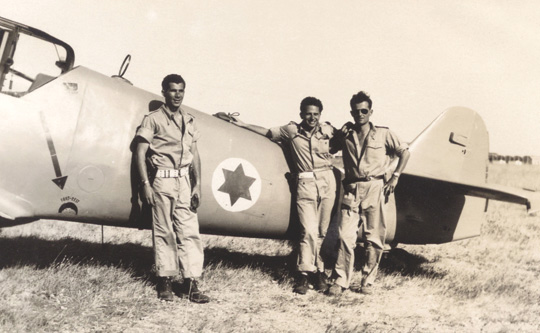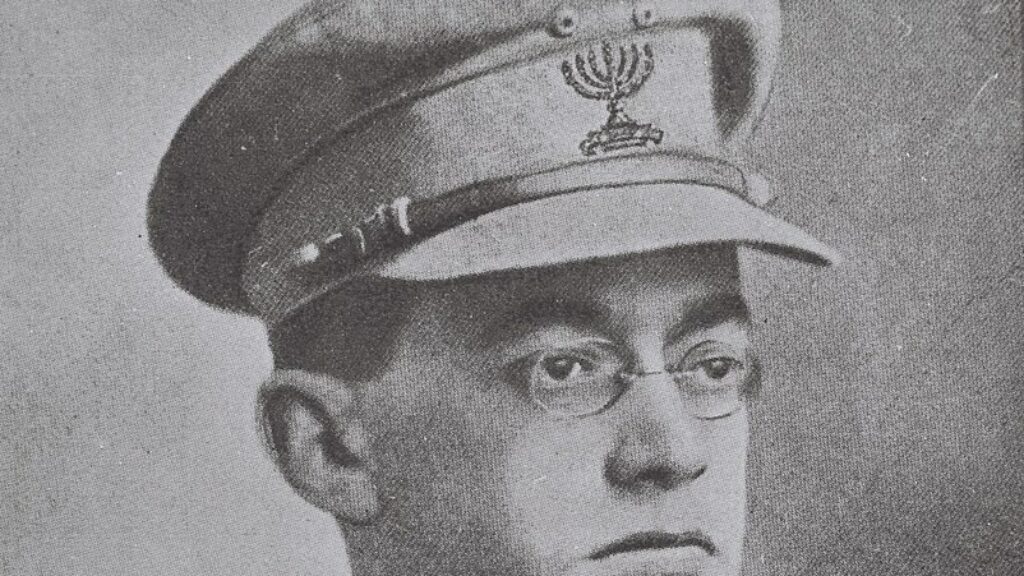An Al Schwimmer Production
When the ancient Spartans sought to aid a friendly state in distress, they did not send troops or arms or money. Instead they dispatched one man—a general—whose role was to take command of the ally’s forces, whip them into shape, and lead them to victory. Thucydides tells us, for instance, in his History of the Peloponnesian War, how the Spartan commander Gylippus saved Syracuse from a massive Athenian invasion and nearly ruined Athens in the bargain.
In early May of 1948, the yet-to-be-born state of Israel was in desperate need of foreign allies. The armies of five Arab nations—Egypt, Jordan, Syria, Lebanon, and Iraq—stood poised on its borders, ready to invade the instant Israel declared its independence. Azzam Pasha, the Secretary General of the Arab League, made their intentions clear: “This will be a war of extermination and a momentous massacre, which will be spoken of like the Mongolian massacres and the Crusades.”
No Gylippus sailed to the Jewish state’s aid. The United States not only failed to dispatch assistance but also embargoed all shipments of arms to the Middle East. Adhering to the Neutrality Act of 1939, the FBI and State Department worked to prevent U.S. veterans of World War II from aiding Israel by donating their military skills or services. Revocation of citizenship was among the penalties for any American arrested “serving under a foreign flag.”

of the International Film Circuit.)
The Egyptian Air Force, meanwhile, possessed 50 brand-new Spitfires, the superb fighter plane that had won the Battle of Britain, donated by England. Israel had no fighter planes and no pilots with combat experience. Who, then, came to Israel’s aid? This is the subject of an extraordinary and stirring new documentary from producer Nancy Spielberg and director Roberta Grossman entitled Above and Beyond.
Lou Lenart came. A Marine fighter pilot from Los Angeles, Lou met a Haganah agent in New York who sent him to Israel via Rome. He was joined in Rome by Coleman “Collie” Goldstein of Philadelphia, a B-17 pilot who had been shot down over France in 1943 and had crossed the Pyrenees on foot to make his escape.
Leon Frankel came from St. Paul, Minnesota, a torpedo-plane pilot who had won the Navy Cross for heroism. George Lichter came, a combat vet who had flown P-47 Thunderbolts and P-51 Mustangs; Gideon Lichtman and Milt Rubenfeld and Harold Livingston and Bob Vickman and Stan Andrews, and others (not all of them Jews) came from Canada, Australia, England, New Zealand, South Africa. All in all, 190 machalniks came from around the world (out of a total of around 3,500 volunteers for all services) to serve in the Israeli Air Force.
Here’s Lou Lenart, describing how the fledgling Israeli Air Force acquired its first four fighter planes, patched-together Messerschmitt-109s, called by their Czech assemblers mezeks, “mules”:
This plane was the worst piece of crap I have ever flown. It had been cobbled together by the Czechs from mismatched parts left behind by the Nazis. The airframe was from a Messerschmitt-109 but the propeller and the engine came out of a Heinkel bomber. You can’t build a plane that way. But it was all we could get, so we took it. There’s a phrase in Hebrew, En brera—“No alternative.” That was us and that was Israel.
On May 14, 1948, Prime Minister David Ben-Gurion declared Israel’s independence, and five Arab armies immediately invaded. An Egyptian column crossed the border at Gaza and began its drive up the coast road to Tel Aviv. Kibbutzniks at Yad Mordechai put up a heroic stand, with women fighting in the trenches alongside the men, but were overrun. Above And Beyond makes great use of archival footage. When you see the scale of the armored columns of the Egyptians and especially the Iraqis the pitifully underequipped Israeli defenders faced, the extent of the emergency becomes vividly real.
By May 29 the Egyptian army had advanced to within 17 miles of Tel Aviv. The four Czech Messerschmitts had been flown, in pieces, to Ekron airfield in Israel (today’s Tel Nof Airbase) and hastily assembled. Lenart and a handful of pilots didn’t dare take the planes up, even to test the guns, for fear that they’d be discovered by the Arabs.
Suddenly, at three in the afternoon, Shimon Avidan, commander of the Haganah troops holding off the Egyptians, raced onto the base. He told Lenart to get his planes into the air at once to attack the enemy. “There’s no alternative, Lou. If the Egyptians break through now, they’ll be in Tel Aviv tonight and that’s the end of Israel.”
Lenart led the four-ship formation. “That was the air force of Israel,” he says in the film. “These four people and four junk airplanes.” Lenart’s #3 was Ezer Weizman, nephew of Chaim (Ezer dropped one “n”) and future chief of the IAF. Within minutes Lenart’s tiny formation spotted the Egyptian column, extending “as far as the eye can see, with tanks and trucks and artillery.”
This is the moment I was born for. I believe that. Behind us is Israel, the Jewish people hanging on by a thread. Ahead of us is the enemy, advancing to destroy everything we love.
We attack. The guns malfunction; the bomb releases balk. I look right and left and see nobody. Anti-aircraft fire is ferocious. Six thousand Egyptians are putting up everything they’ve got. Eddie Cohen, a wonderful, brave pilot from South Africa, must have run into too much of it. His plane doesn’t come back. I manage to put one 70-kilogram bomb onto a concentration of trucks and troops in the town square of Ishdud and to fly a few “cloverleafs,” strafing. Modi and Ezer do what they can. It’s a mess. We straggle back to base, having inflicted minimal damage.
But the psychological shock to the Egyptians is devastating. To be attacked from the air by Messerschmitt-109s with the Star of David on the sides! For all the enemy knew, our four planes were the vanguard of hundreds more.
That night the Haganah defenders hit the enemy from the flank. Israeli intelligence intercepts this dispatch from the Egyptian brigade commander to his superiors in Cairo:
We were heavily attacked by enemy aircraft and we are scattering.
With Israel’s present status as a major military power in the Middle East, it is easy to forget how desperately poor Israel was in 1948—short of food, armaments, everything. Some may have never learned that the nation’s population at its founding was only 600,000, standing against more than 50 million Arabs and that 6,000 men and women (fully one percent of the population) died in Israel’s fight to survive its birth.

That the IAF had planes to fly was principally the achievement of a U.S. Air Force veteran named Al Schwimmer. Schwimmer ducked and dodged the FBI and the Treasury and State Departments and, virtually singlehandedly, acquired and refitted the aircraft that would become the fledgling IAF. (Schwimmer was eventually convicted under the Neutrality Act and lost his U.S. citizenship; he stayed in Israel and founded the Israeli aircraft industry. He was pardoned by President Bill Clinton in 2001.)
With money donated by American Jews, Schwimmer bought up World War II surplus planes, C-46s and C-69 Constellations and B-17s (a plane could be acquired by a vet then for as little as $5,000), hired mechanics to make these aircraft flight-worthy, then, disguising them as civilian airliners of the fictional Lineas Areas de Panama, had them flown via Panama and Brazil to Casablanca, then to Rome, Czechoslovakia, and on to Israel.
Schwimmer’s story was in fact the impetus for Above and Beyond. “When I first read the obituary that hooked me, ‘Father of the Israeli Air Force dies at 94,’” says producer Nancy Spielberg, “I thought, What a great story this is and why don’t I know anything about this! It had all the makings of a big picture, a ‘Spielberg film.’ It had heart, it had adventure, intrigue, and a little bit of sex . . .” (Nancy is Steven’s sister.) She continues:
Most of the fly boys that we interviewed were not at all in touch with their Jewishness; it had gotten them nowhere: They had been beaten up walking home from school in an anti-Semitic environment in the U.S. They couldn’t get jobs as pilots in commercial airlines. So, when, for various reasons, they found themselves embarking on this journey to aid Israel—an illegal one, at that—they also unconsciously were embarking on a journey of self-discovery and Jewish pride.
Harold Livingston describes arriving at Ekron air base and encountering for the first time the warriors of the Haganah, men and women, fit and lean and disciplined. “I remember coming into the hangar and seeing all these people in uniform. These are Jews? My cynicism vanished very rapidly, I’ll tell you that.”
By the end of the War of Independence, home-grown pilots had been trained, and the Yanks and Aussies, the Brits and Canadians and South Africans could shake hands with their counterparts and take their leave with honor. In the film, Leon Frankel describes one moment that has remained with him:
Shortly before I left Israel I happened to be in Tel Aviv when [the ships] were bringing in refugees from the death camps in Europe. I remember them getting down on their hands and knees and kissing the ground. I knew then and there that that was the reason why I came.
Above and Beyond is the Spielberg movie to see this year.
Comments
You must log in to comment Log In
Suggested Reading

Do Jews Count?
I would never have said this ten years ago, or even five years ago, but there apparently comes a time in the lives of those who write about Jewish identity when they have to decide whether to write about . . . it.

Tragedy and Comedy in Black and White
Lately it seems to be the season of haredim on screen. Sarah Rindner's immersion in this very particular oeuvre began with Shtisel, the 2013 runaway hit Israeli TV series, which depicts a haredi family in Jerusalem in all of its complicated, charming dysfunction.
What Is a Jew? The Answer of the Maccabees
In 1958, David Ben-Gurion sent a letter to fifty Jewish leaders around the world, asking, "Who is a Jew?" He had good political reasons to launch such an inquiry, and equally good reasons to expect answers or attempts at answers. Isaiah Berlin wrote back, and so did the Jewish scholar Alexander Altmann, the novelist S.Y. Agnon, and the Lubavitcher Rebbe, as well as many others. But Abba Hillel Silver, the prominent Reform rabbi and American Zionist leader who had represented the Jewish Agency before the United Nations a decade earlier, did not respond to Ben-Gurion's missive—not directly, anyhow.

A Sharp Word
From his intensive study of Hebrew and Jewish history to a surprisingly romantic Zionist congress in Basel, and the horrors of the Kishinev Pogrom, 1903 seems to have been a turning point for the young Jabotinsky.
diane gottheil
My friend the late Trygvie Massing came from Illinois. He wasn't Jewish, yet.